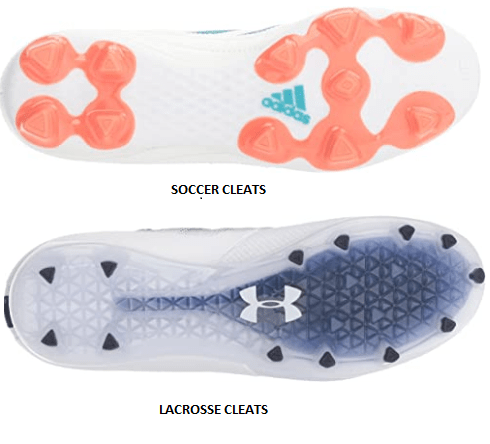Even at a glance, soccer and lacrosse are two sports that have many differences. In both of these, the goal is to bring the ball to the opponent’s net. However, in soccer, the ball is moved by your legs, while in lacrosse, you use lacrosse sticks. The game is played on grass or turf, so players will have to wear a specific type of shoes in both cases.
So, are the soccer cleats any different against the lacrosse cleats? Lacrosse cleats have a higher cut and are a little heavier than soccer cleats because of that. Also, the stud configuration is a bit different as lacrosse cleats have an extra front stud in the big toe, which is not allowed in soccer.
Let’s try to break down all the pros, cons, and differences between soccer and lacrosse cleats.
Lacrosse cleats vs soccer cleats
The main differences are listed in the table below.
Soccer Cleats | Lacrosse Cleats |
|
|---|---|---|
Style | Low-cut | High-cut |
Stud configuration | No toe stud and the studs have different styles. | An extra stud near the big toe and the studs are placed in the edge of the outsole. |
The Shape and Position of the Cleats
First off, we will compare the design and purpose of the cleats themselves. In soccer shoes, the cleats are usually made longer than in lacrosse. In lacrosse, the length of the cleats is limited to half-inch (12.7 millimeters), while the cleats on soccer shoes can be longer than that. Also, lacrosse spikes are mainly placed in the edge of the outsole.
The placement of cleats on the sole of the shoe is also very similar. There are usually 4 studs on the heel of the shoe, and between 6 and 8 cleats on the front part of the foot. One big difference, though, is that lacrosse cleats as with football cleats have a stud at the end of the toe, while soccer ones don’t. This means that you can’t wear lacrosse shoes in soccer, as they aren’t considered safe.
Metal cleats are not allowed in lacrosse. On the other hand, on professional soccer metal cleats are permitted. There are many cases, though, that metal cleats are forbidden in soccer. You can read more about the rules for metal cleats in soccer here.
In both sports, the more expensive models provide players with the option to replace the cleats, depending on the weather.
How High Is the Ankle Support?
This is the main difference between these two types of shoes. Lacrosse cleats usually have a higher cut. This is done because players make more lateral movements in lacrosse, so they need sufficient ankle support when running. It should be noted that faster players may prefer a lower cut on their cleats since high-cut shoes are more restrictive.
Soccer shoes, on the other hand, are generally all low-cut. This is done because players need to make frequent direction changes, and cleats with a higher cut would restrict their movements too much. Another perk of low-cut shoes is that their weight is lower, but this difference may not be very notable.
I have written a more detailed article for soccer players who are seeking boots with better ankle support.
Shoe’s Weight
The weight of soccer and lacrosse shoes is very similar. The biggest difference would be the few extra grams on the lacrosse cleats that remain because of the higher cut. This shouldn’t be noticeable when running on the field, though.
Both soccer and lacrosse cleats fall in the midweight category when compared to other sports. For example, football cleats are heavier, while track and field cleats are lighter.
Both types of cleats are made from similar materials so the impact on the weight is not meaningful. Synthetic leather is commonly used and the shoes are usually made to absorb moisture and keep your feet dry. Of course, this mostly depends on the model of the shoe and its price.
Are There Any Price Differences?
Some of the most expensive lacrosse cleats models can be bought for less than 120 dollars. The cheapest ones will go for as low as 20 bucks.
Most of the soccer cleats models can also be found in this price range. The most expensive soccer cleats will cost much more than this, though. Some models will cost around 250 to 350$. Soccer is way more popular than lacrosse worldwide, so soccer brands have invested more money and human resources to create technologically advanced shoes, and that has increased to cost significantly.
Soccer cleats can also be similar with football and lacrosse cleats. I have written a different article with the difference between soccer and football cleats and one with the difference with baseball shoes.
Can you wear lacrosse cleats for soccer?
In that question, the answer is straightforward. You should never wear lacrosse shoes for playing soccer because of the extra toe spike in the front of the outsole, which can lead to injuries. As we have seen in another article, that is also the case with football cleats.
Soccer rather than lacrosse or American football is played with the feet. That involves kicking the ball and tackling the opponent to take possession of the ball. The stud configuration has been designed with that in mind to avoid injuries after contact between players’ feet.
Furthermore, the official soccer rules prohibit soccer players from wearing lacrosse cleats as that can be considered dangerous for soccer players. More specifically law 04it states:
- A player must not use equipment or wear anything dangerous. (Section 1)
- Footwear is “compulsory equipment.” (Section 2)
It is not stated officially but most likely referees will not let you play soccer with lacrosse cleats. And even if you play recreationally or just for training you should probably avoid tham for safety reasons.
Can you wear soccer cleats for lacrosse?
If this were a simple “yes or no” question, we would say “yes” without any second thoughts. However, the answer is not that simple. You can wear your soccer cleats when playing lacrosse without any problems. All field sports usually have similar requirements for cleats, and it won’t be an astronomical difference if you stick with soccer shoes.
Players that rely on speed may even prefer soccer cleats when playing lacrosse, as there can be some acceleration gains. Soccer cleats should also increase your stopping and starting capabilities.
Despite that, any lacrosse player should strive for as much ankle support as he can get. Soccer shoes lack this feature as they have a low cut. You may encounter some problems when doing lateral movements if you are using soccer cleats while playing lacrosse. Also, the weight difference exists, but it isn’t significant. Although soccer shoes are generally lighter, you probably won’t be noticing this when playing.
When considering the buying expenses, although some models of soccer cleats can be very pricey, most of them will fall in the same price range as lacrosse cleats. The most expensive lacrosse cleats cost less in general, though, and you can buy the priciest model on Amazon for 110 dollars. However, when purchasing soccer cleats, there are many more models in various price ranges. You will have more options to choose from. Soccer has a larger pool of players and this difference is to be expected.
It’s also essential to choose shoes that you feel most comfortable. Try to get your hands on some spare ones and do a test run. This is the best way to check if you have any preferences and to compare both types without biases or peer pressure. Many lacrosse players prefer and use soccer cleats, so the best thing to do is to wear shoes that fit your playing style the most.
All in all, wearing soccer cleats when playing lacrosse shouldn’t be a problem. Which shoes are better suited for the job? It all depends on who you ask. Generally speaking, lacrosse cleats should have a certain edge because they are specifically made for lacrosse, but some players will find soccer shoes more comfortable. Personal preference tends to be the most significant factor here, and you can’t go wrong no matter which option you choose.
Finally let’s see what the official lacrosse equipment guide has to say about this. All the shoe sections state that athletic shoes are required, without any specific mention to soccer cleats. Only goalkeepers need to wear rubber sole athletic shoe. So if you are playing in official games and you are not a goalkeeper you can wear soccer cleats if you want. It all comes down to personal preference.





